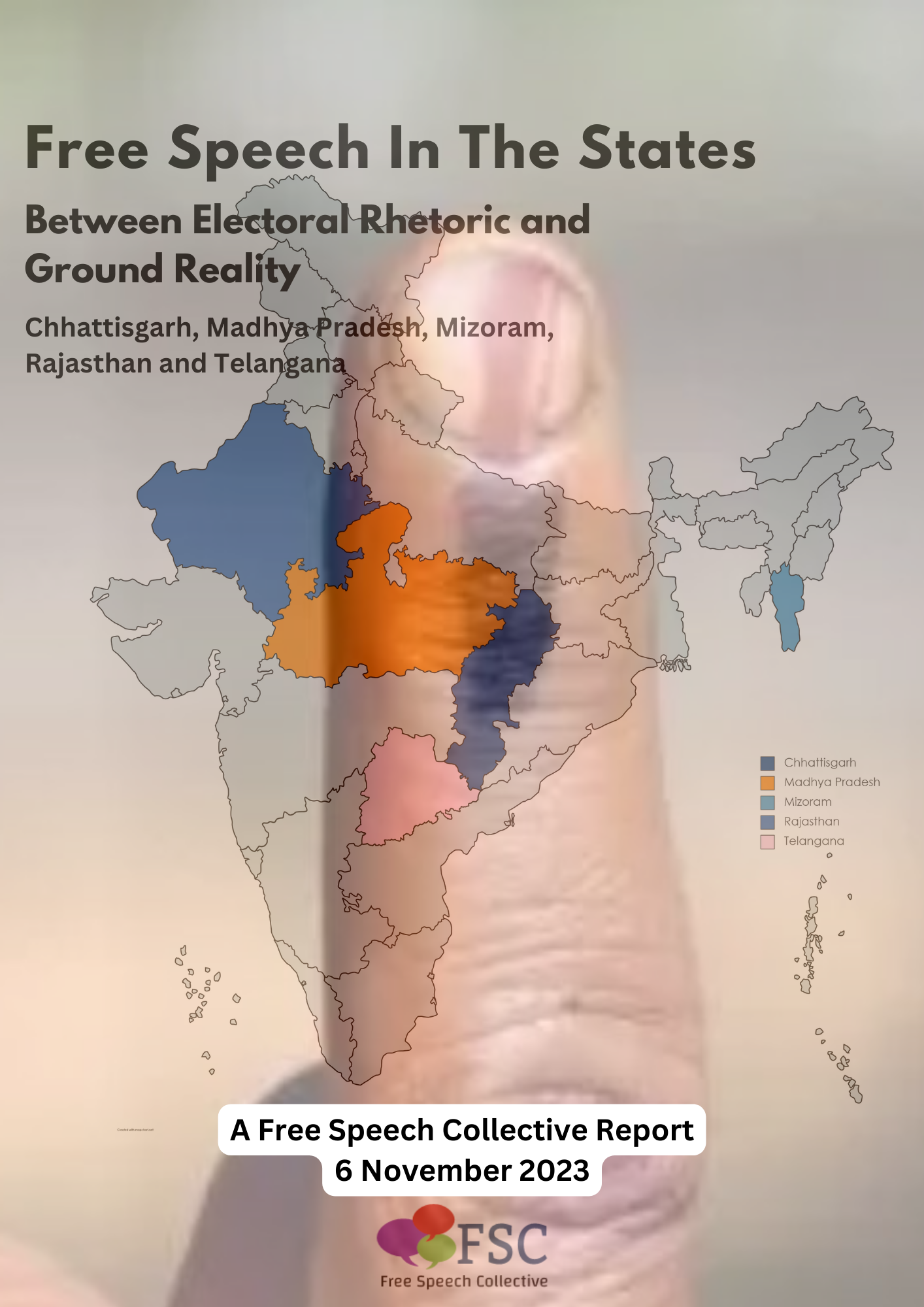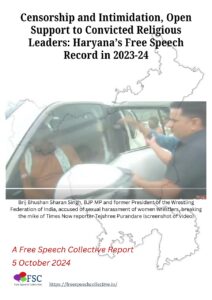
A Free Speech Collective Report on the health of freedom of expression in the five states (Chhattisgarh, Madhya Pradesh, Mizoram, Rajasthan and Telangana) that go to the polls from November 7, 2023.
Scroll down to read the report
Click here to download the full report.
From 7 November 2023, five state assemblies go to the polls – Chhattisgarh, in two phases, on 7 November and 17; Mizoram on 7 November; Madhya Pradesh on 17 November; Rajasthan on 23 November and Telangana on 30 November. While voters are faced with a myriad of issues, including unemployment, corruption, health care, safety of women, displacement due to infrastructure projects, farm loans and pensions, there are grave silences over accountability and transparency in governance.
Over the last five years, journalists and RTI activists in these states have been killed, arrested and attacked for their work. Censorship was an abiding feature, either due to government policy or through the weapon of ‘lawfare’, as journalists were slapped with cases ranging from sedition to defamation, causing disharmony and enmity, often struggling with multiple FIRs registered in different police stations.

As the arrest and over two-month long incarceration of reporter Jaalam Singh, charged with seven FIRs in Guna and Shivpuri districts in Madhya Pradesh indicates, such repressive action has had a chilling effect on journalism. If on the one hand, there is acute self-censorship, on the other, there is a woeful absence of the critical questioning that would otherwise be the hallmark of investigative journalism. In both scenarios, the net result is deliberate silencing.
As Suman Kirar, Jaalam Singh’s wife said bitterly, “Instead of questioning and protesting the arrest of a colleague, all these ‘positive’ stories are being published. A journalist who refused to take money or remain silent is still in jail.”
The term of the outgoing state assemblies was also marked by the Covid-19 pandemic and shutdown from March 24, 2020. There is already extensive documentation on the restrictions on the media during the unprecedented nation-wide lockdown. In Madhya Pradesh, the scare over the virus resulted in suspension of print media publications in 95 per cent of the state’s districts.
But journalists faced the brunt of covering the pandemic. In Telangana, under review as one of the five states that goes to the polls, bulldozer policing was used to devastating effect on May 22, 2020 to raze to the ground the residence of V6 News Channel journalist Shanigarapu Parameshwar, who reported on the birthday party of MLA Mahareddy Bhupal Reddy with 500 supporters in violation of the lockdown in Narayankhed, Telangana.
While Chhattisgarh was one of the few states which offered financial assistance of Rs 500,000 to dependents of media persons who died due to Covid-19 under the Media Representative Welfare Assistance Rules, journalists in this state faced the brunt of ‘lawfare’, being charged under multiple sections of the law for reporting on sand mining and other corruption at local levels.
Despite government assurances and the passage of a media protection law, journalists on the ground were vulnerable to false cases. In Surguja division alone, which comprises six districts, 22 journalists have faced the brunt for their reporting, most of whom have been arrested or have had cases slapped against them.
Take the case of Sunil Namdev, who runs a YouTube channel News Today. Reporting on Covid violations by the ruling party members; corruption in construction; the arrest of senior IAS officers who colluded with the Congress government in the coal mafia scam, promptly landed him in jail, where he still is lodged since May 2023. Jitendra Jaiswal, a journalist from Ambikapur who runs a digital news platform, Bharat Samman has 12 cases against him – one during the 15-year-old BJP rule and the rest in the last five years of Congress rule. Jaiswal has recently been given a notice of ‘jilla badal’ (externment) placing him under the list of ‘gunda-badmash’ (gangster).
Internet shutdowns are normalised, despite the immense resultant disruption in peoples’ lives. Shutdowns were implemented ignoring the guidelines laid down by the Supreme Court of India in the Anuradha Bhasin case. In Rajasthan alone, of the five states under review, the Internet was shut down on a whopping 72 occasions recorded by the FSC State Index, a majority of which were to clamp down on protests.
In Mizoram, access to information has been the biggest challenge and journalists’ bodies have been hampered by attempts by the government and border security forces to restrict their movements and regulate permission for news coverage in border areas. Mizoram, which goes to the polls on November 7, shares a border with Manipur and its government has come out in support of the Kuki-Zo community in the wake of the ongoing conflict in Manipur. Its government has stated that it will ignore the Union home ministry’s order to collect biometric data of refugees from bordering Myanmar who have crossed the international border to flee from the junta.
Right to Information (RTI) activists also faced curbs on the right to free speech, and were vulnerable to murderous attacks. In a chilling case against an RTI activist and retired Mandal Parishad Development Officer (MPDO) in Telangana, 70-year-old RTI activist Nalla Ramakrishnaiah was killed in Jangaon district and his body dumped in a water-filled quarry after he complained about irregularities by the accused, G Anjaiah, in a land issue.
Overall, there has been a steady deterioration of freedom of expression in India and there is overwhelming evidence of journalists killed, attacked, arrested, charged for their investigative work, intimidated or denied access to the gathering of news and information in the public interest or bluntly censored and silenced. India fares badly in global indices of press freedom organisations.
India has slipped to 161 in rankings of the World Press Freedom Index maintained by Reporters Without Borders (RSF) and ranks 11th on Global Impunity Index 2022 of the Committee to Protect Journalists.
Ironically, even as hate speech is given full rein (for e.g., the wave of communal speeches and clashes in Ujjain, Mandsaur and Indore districts of Madhya Pradesh between December 2020-January 2021), there are increasing restrictions and regulations of freedom of expression not just for the news media. Artists, academics, stand-up comedians, writers, filmmakers, citizens and intellectuals who use social media or speak at public meetings and discussions have found themselves arrested or face criminal charges. Slowly but surely, the space for dissent is shrinking and independent voices are being silenced or penalised.
As the five states go to the polls, it is worth noting that the Indian National Congress in its 2019 manifesto on “Media and Press Freedom” promises reform in regulatory bodies to tackle paid news, disinformation and media monopolies, and promises to work with state governments to protect journalists working in conflict areas or those investigating matters
of public interest. Free speech is not a specific poll issue in the manifesto of any of the other political parties.
In this context, this report on ‘Free Speech In The States’ seeks to examine the health of freedom of expression in the five states that go to the polls.
———————–
About Free Speech in the States
Free Speech in the States is a state-wise monitor of freedom of expression in India by the Free Speech Collective (FSC), comprising data on the number and nature of instances of free speech violations, cases, perpetrators and the mechanisms for justice delivery (or the lack of it) and an analysis of the state of free speech in the states of India.
This study of the five states going in for elections to the State Assemblies – Chhattisgarh, Madhya Pradesh, Mizoram, Rajasthan and Telangana – examined press freedom violations as well as free speech issues in other areas for the five-year term of the governments in these states.
The categories recorded were: Killings of journalists; arrests; detentions; deportation; arrest of other citizens; attacks on journalists; threats; censorship, Internet shutdowns, cases of defamation, sedition and contempt of court, clubbed under the term ‘lawfare’ to indicate overuse and misuse of laws to silence dissent).
The report records cases, police investigations and action and court cases and judgements in this period. It includes news reports, monitoring of existing cases, interviews with key stakeholders along with a brief contextual background into each state and a brief summary of laws affecting freedom of expression.
Team
Geeta Seshu
Laxmi Murthy
Malini Subramaniam
Sarita Ramamoorthy
Website: https://freespeechcollective.in/
Grateful acknowledgements
Assistance with data input, Shabari Rao.
Ground level inputs and analysis from journalists and human rights activists in Chhattisgarh, Madhya Pradesh, Mizoram, Rajasthan, and Telangana.
While every effort has been made to document and verify all instances, please do write to
freespeechcollectiveindia@gmail.com if any incidents or instances warrant inclusion or amendments.


